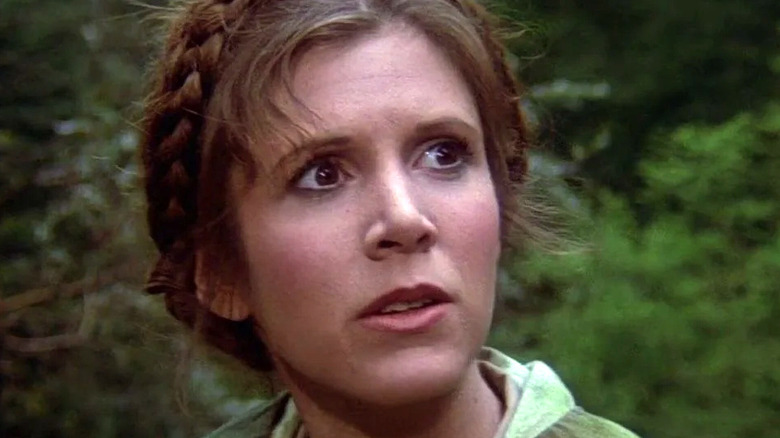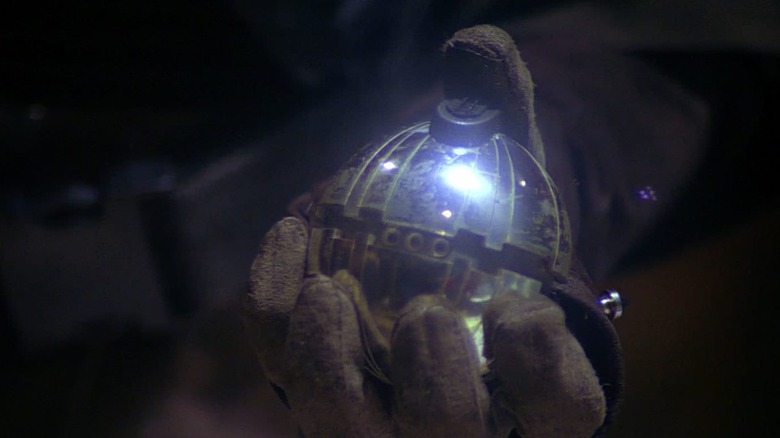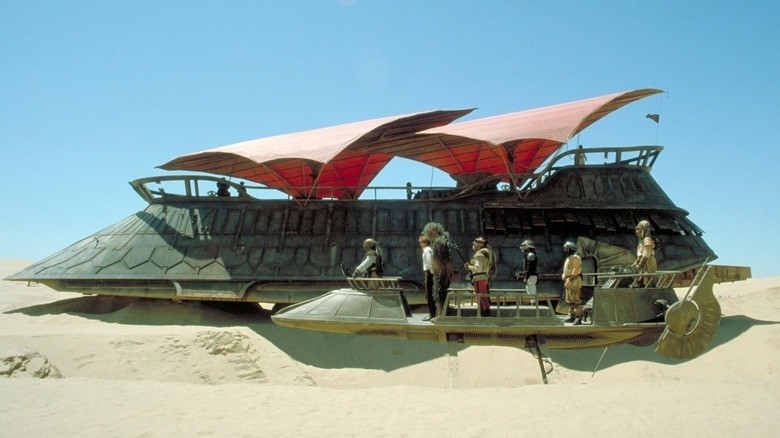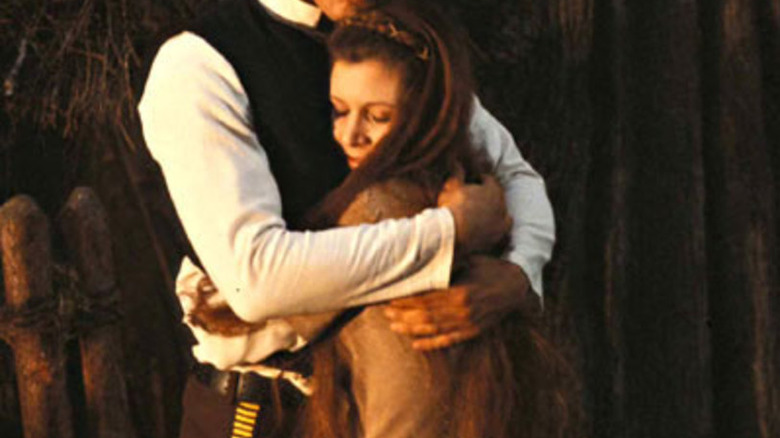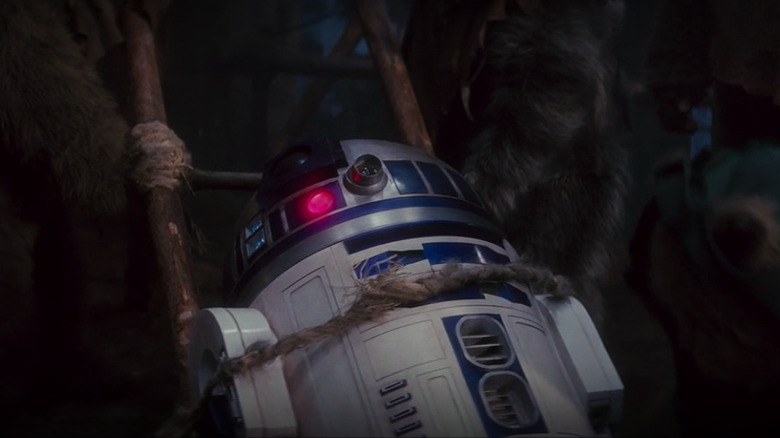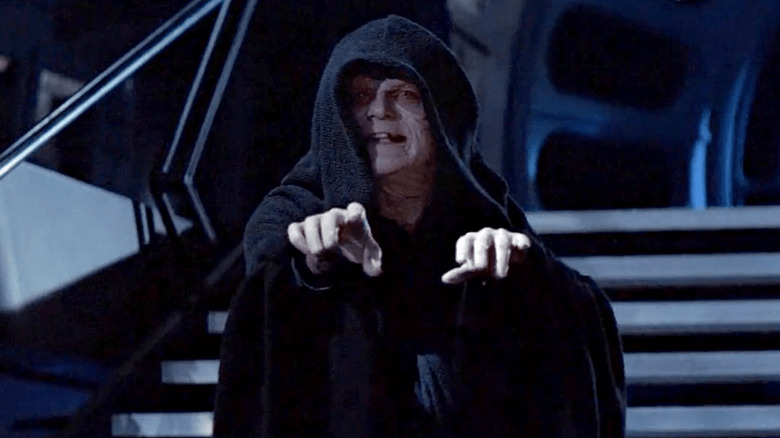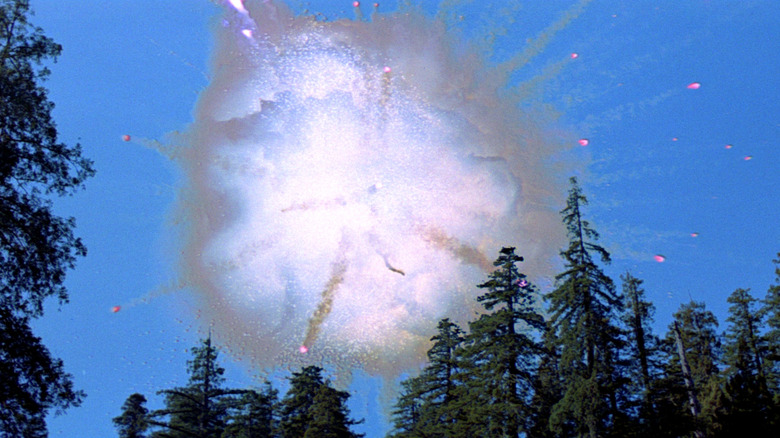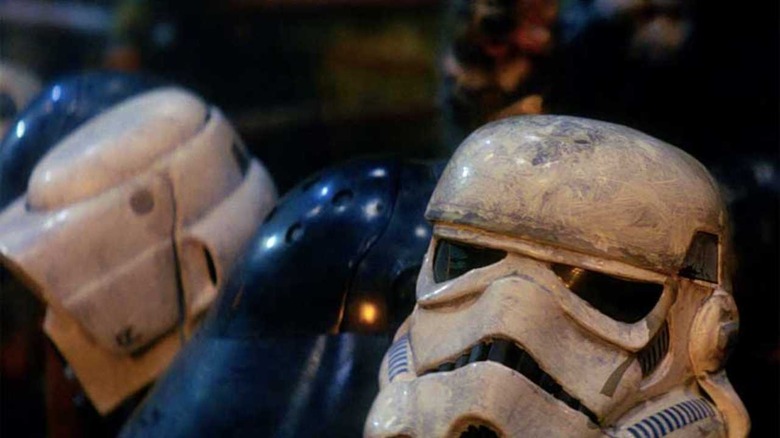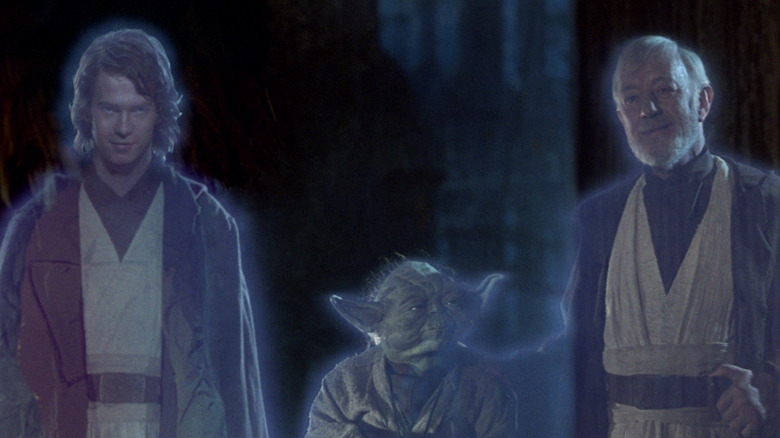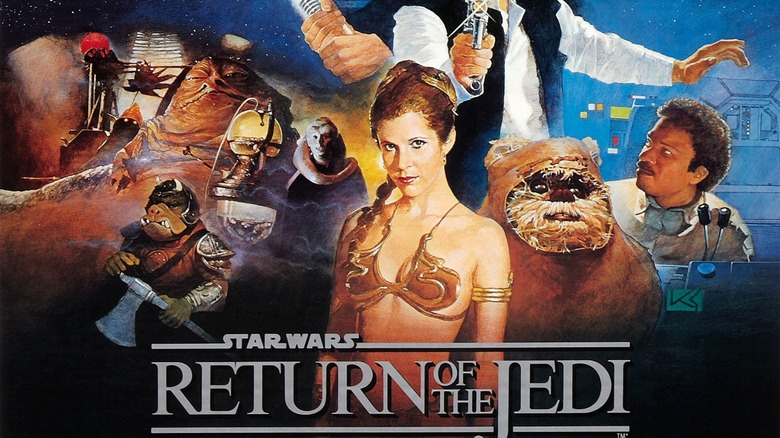The Biggest Unanswered Questions In Return Of The Jedi
After the smashing success of the first two "Star Wars" movies, 1983's "Return of the Jedi" arrived to wrap everything up. (Or at least, that was the idea at the time — the franchise doesn't seem to be going anywhere anytime soon.) 1980's "The Empire Strike Back" ends on a major cliffhanger: Luke learns Darth Vader is his father and loses a hand, Han Solo is frozen in carbonite, and the good guys seem pretty much screwed. Even today, "Empire" leaves first-time viewers full of storytelling expectations. Going into "Return of the Jedi," "Star Wars" promises to reveal the mysterious "Jabba" Han has alluded to throughout the series, unveil the meaning of Obi-Wan's cryptic statement, "There is another," and discover the truth behind Darth Vader's shocking revelation. Most of all, it promises to showcase how the Rebel Alliance will defeat the Empire once and for all.
"Return of the Jedi" does indeed successfully tie up all these plotlines. But it also raises what Outkast might call a stack of questions with no answers. After countless sequels, prequels, and multimedia tie-ins, there's still a lot we can't figure out about the final chapter in Lucas' original "Star Wars" trilogy. Here are a few lingering questions regarding "Return of the Jedi" we're still puzzling over.
How does Leia get the thermal detonator through security?
Jabba the Hutt's illegal empire has made him one of the most powerful men on Tatooine, evidenced by his ornate palace full of slaves, entertainers, soldiers, and assorted hangers-on. You don't accrue that kind of power without working to hold onto it: Even before we see Jabba, we know he takes his safety very seriously. After a prologue with the bad guys, "Return of the Jedi" opens with R2-D2 and C-3PO strolling across the desert to Jabba's palace, where C-3PO is appropriately intimidated by the enormous, impenetrable metal door. Before they can go inside, a glass eyeball on a metal arm pops out to give them a good scan.
Apparently, though, whoever installed that thing cut some corners. A few scenes later, Princess Leia, disguised as the bounty hunter Boushh, arrives with Chewie, allegedly to collect the bounty on his head. She tries to negotiate for a higher price, and when Jabba asks why he should pay it, Leia pulls out a metal globe that C-3PO helpfully explains is a "thermal detonator." Somehow, Leia managed to get it past not just the scanner, but the army of flesh-and-blood guards Jabba keeps with him at all times. If it's that easy to kill the most powerful man on Tatooine, how has he lived this long? Then again, we learn later that R2-D2 hid Luke's lightsaber in one of his secret compartments, so obviously this isn't the first time the scanner has screwed up.
How many of Jabba's slaves do the good guys murder?
When Jabba takes Luke and his friends out on his flying pleasure barge to execute them, the rebels turn the tables and massacre him and his whole retinue. After Leia chokes the gelatinous mob boss with the chain he's kept her bound with, the rest of the crew escapes and blows up the whole barge. Another clear-cut victory of good over evil, right?
Well, not so much. The whole affair starts to get more and more morally murky the longer you think about it. Luke is able to get all his friends on the barge with him because they allow themselves to be captured by Jabba and used as his slaves — R2-D2 even gets converted into a drink tray. While a lot of the security detail Luke and Han battle are pretty obviously bad dudes, from what we see in Jabba's palace, most of the people he keeps around him would rather be anywhere else. In fact, they're explicitly described as slaves who live in constant fear of Jabba's displeasure, as we learn from the poor dancer who turns down his advances and gets thrown to the monster in the cellar. From what we see of the pleasure barge, we know a lot of those unfortunate people make the trip with their master. Normally, you'd expect a wholesome hero like Luke Skywalker to rescue these slaves from their miserable lives, especially since his loved ones briefly suffer that fate themselves. And he does, from a certain point of view — by blowing them all to heck.
Where did the Ewoks get Leia's dress?
Once they've gotten the gang back together, the rebels receive their next mission. The Empire is building a new planet-destroying Death Star, but thanks to the sacrifice of "many Bothans," our heroes know where they can find the shield generator that protects it from attack: the forest moon of Endor. The main cast are separated on arrival, and Leia becomes the first to meet the diminutive Ewoks, Endor's inhabitants. Later, the rest of the heroes set off a hunting trap and find themselves meeting the Ewoks as the meat for the village's next meal. Once Luke uses his Jedi powers to convince the little critters to let them go, they're reunited with Leia, who has changed from her regulation camouflage poncho and helmet into a light brown dress.
Now, the Ewoks are all around the size of a human toddler, so they couldn't have lent Leia any of their own clothes. It's also pretty hard to imagine them making a new garment from scratch in the couple of hours that pass between seeing Leia in her old duds and her new ones. What the heck is going on? One meme shared by writer Brad Meltzer on Twitter and later picked up by Mark Hamill himself suggests a disturbing possibility: The Ewoks cooked and ate a humanoid woman around Leia's size. We already know the Ewoks are man-eaters, based on their plans for the other rebels. Could they have saved the dress after roasting some poor lady who had the misfortune to run into them? It's entirely and horrifyingly possible.
Were the Ewoks going to cook R2?
The Ewoks' dinner plans raise a smorgasbord of questions. Before they get started cooking our heroes, they tie them up on stakes with grass ropes, apparently planning to spit-roast them. Well, except for C-3PO, who the Ewoks think is their god. The rest of the gang, however, find themselves in a decidedly unsavory predicament: Luke, Han, Chewbacca, and ... R2-D2. Yep, the droid is tied up and ready to roast, just like the others. But, being a robot, there's not much there to eat ... which one would assume the Ewoks understand. Seriously, what could the Ewoks have planned for him? They'd be picking springs out of their teeth for days — and that's if they don't break all their teeth trying to bite off a hunk of iron. They might not be the most sophisticated creatures around, but they do seem likely to know the difference between meat and metal.
The most likely explanation for this is that they don't actually have R2-D2 tied to a spit, and are just trying to keep him from getting loose and rescuing his friends. But that doesn't really add up either. Why take him up to the treetop village at all, in that case? It would have been way more efficient to just leave R2 tied up where they found him, instead of having to lug the heavy droid 10 stories up. There's only one possible explanation: R2 needed to be with the other characters for the story to move on, no matter how little sense it makes. And hey, why not? Odds are, these questions didn't even occur to you until you read this, and you'd definitely be wondering where R2 went if the filmmakers hadn't fudged the logic a little.
Why does the Emperor leak the actual plans?
Luke learns just how many steps ahead the Emperor is when the old man reveals that he leaked what the rebels thought were secret plans for the supposedly incomplete Death Star's shield generator. He did this to lure our heroes into a trap, so that he might wipe out the Rebellion's forces both on Endor and in space with what he crows is a "fully-armed and operational Death Star!"
It's a brilliant plan. Or at least, the script says it is. But the attentive viewer (or, to be honest, even the fairly casual viewer) should be able to find some holes in it. The most obvious, of course, is retroactive: The plan simply doesn't work. The rebels on the ground destroy the shield generator, making it possible for their aerial bombers to destroy the Death Star. Instead of leading the rebels into a trap, Palpatine gives them everything they need to win the war. And it all could have been avoided if he'd just taken a second to realize one simple thing: As long as he's feeding the rebels his plans, there's nothing stopping him from giving them fake ones.
This all fits with the Emperor's hubris, of course, and it's certainly not like real world leaders are above making these kinds of mistakes. But if this is the level of strategy the Empire has been working with, it's a wonder it didn't collapse in the first two weeks.
What happens to all the shrapnel from the Death Star?
In the end, the rebels successfully destroy the Death Star, and everyone on Endor celebrates. But if "Return of the Jedi" were more realistic, we'd see them all running for their lives. We get a pretty good look at the imperial satellite blowing up in the sky over Endor, and it looks awfully close. We specifically see a lot of fragments flying out in space. What happens when they hit the moon's surface?
Many scientists agree that in real life, the impact of a celestial body changed the Earth's climate so drastically that dinosaurs went from being the dominant life form on the planet to fossil fuels. What slammed into the Earth's surface may have been around 10 miles wide, but it's not too implausible to believe that any given shard of the Death Star could be that big. Han famously says, after all, that the first one is the size of a moon — how many mass extinction events did that one create when it blew up?
"Star Wars" fans have been discussing what they call the "Endor Holocaust" theory for years. According to Business Insider, multiple physicists have confirmed there's no way Endor would still be around after the Death Star blows up, whether it's destroyed by firestorms, small debris blocking the sun and polluting the air, large debris knocking the moon out of orbit, or radiation hitting them even before the debris makes landfall. As scientist Dave Minton succinctly puts it, "The Ewoks are dead. All of them." But there everyone is at the end of the movie, having themselves a party instead of lying flattened in a crater the size of Africa. Maybe the Force did it.
Did the Ewoks eat those Stormtroopers?
The Ewoks are both loved and hated as the cutest little aliens to ever appear in "Star Wars." They're a gift for the franchise's littlest fans, and an annoying reminder to kids who have grown up since they fell in love with the series six years earlier that their obsession has never been entirely for grown-ups. But are the Ewoks actually all that lovable? After all, we know they have a taste for human flesh, since they eagerly get the primary characters ready for roasting. Fortunately, Luke and C-3PO manage to talk them out of it, but that doesn't mean the Ewoks never hanker for a taste of the old long pig.
Moreover, they may look like teddy bears, but they seem to be about as vicious as grizzly bears based on how easily they're able to overcome the superior numbers and firepower of the Stormtroopers. Director Richard Marquand is smart enough not to spoil the Ewoks' charm by showing us any explicit bloodshed, but we still see them using Stormtrooper helmets as drums in the big victory celebration at the end. It's cute, at first glance, but it raises some disturbing questions. What happened to the Stormtroopers who wore those helmets? We can only hope their heads aren't still inside. Based on the acoustics, they seem empty — but that doesn't put all concerns to rest. Did the Ewoks kill the Stormtroopers who wore those helmets? More importantly, did they eat them? And, if so, did the human heroes join them, or just politely say they were full?
What's up with Anakin's ghost?
After spending two movies as one of the most evil villains the whole of cinema has to offer, Darth Vader shows off a different side in "Return of the Jedi." After learning they're family, Luke willingly surrenders to Vader, in the hope of saving his father's soul. Meanwhile, the Emperor has similar plans, hoping to turn Luke to the Dark Side. In the end, Luke wins, and Darth Vader proves the Dark Side hasn't totally corrupted him by sacrificing his life to save Luke from the Emperor. During the celebration on Endor, Luke ritually burns Vader's armor. Soon after, we see Vader's ghost materialize alongside his fellow Jedi masters Yoda and Obi-Wan. As a specter, he appears whole and healthy, wearing his Jedi robes.
Depending on which version of the movie you watch, though, you may see a different ghost. When Lucas made his second round of changes for the 2004 DVD re-release, he replaced Sebastian Shaw, who plays the unmasked Vader in his death scene and as a ghost, with Hayden Christensen, who plays Anakin Skywalker in the prequel trilogy. Lucas' intention was to give viewers a more familiar version of Anakin, but instead, he just opened a can of worms. First, grafting one of the most loathed performances of the prequels into the beloved original trilogy was never going to end well. But even in terms of storytelling logic, this change doesn't make much sense. Why do Yoda and Obi-Wan appear as the age they were when they died, but Anakin gets to revert to his younger self? Did he get some kind of Premium Afterlife Plan that the other two cheaped out on?
Who does the title refer to, exactly?
George Lucas put a lot of thought into what to call the final chapter of the original "Star Wars" trilogy. According to Entertainment Weekly, he scrapped his original title, "Revenge of the Jedi," so late in the production that a trailer made it to theaters with the wrong name. But Lucas felt the change was necessary, since "revenge" implies an embrace of negative emotions like spite and anger that the Jedi are specifically trained to avoid.
So, if the title "Return of the Jedi" was important enough to merit such a major change so far into production, we need to take a moment to analyze what it really means. The obvious reading would explain it as referring to Luke: Now that he's completed his training, he's become the "Jedi" of the title, and he's returning for another adventure. But "Jedi" can be singular or plural. Could the title also refer to Anakin Skywalker? After all, "Return of the Jedi" sees him redeem himself, thus marking a "return" to his Jedi ideals after years dishing out evil as Vader. Could the title also possibly reference the fact that now that the Empire is defeated, the Jedi as a whole have returned? That's certainly what the "Star Wars" sequel trilogy suggests: After "Return of the Jedi," Luke goes on to become a Jedi master, and trains a new generation of Jedi warriors ... until Kylo Ren brings it all crashing down.
